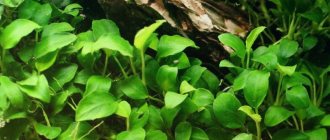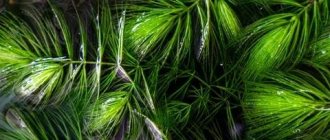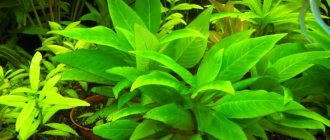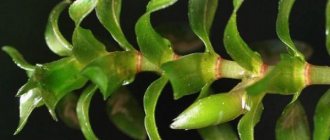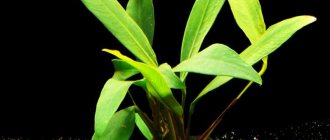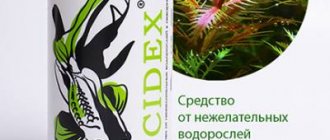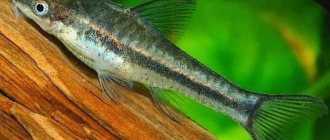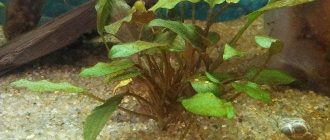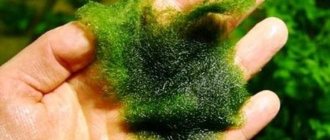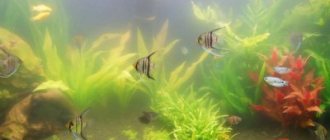Description and types
Aquarium duckweed belongs to the aroid family. In the wild, the plant can often be found on the surface of the water surface of stagnant lakes and swamps. Growing luxuriantly, the floating flower covers the surface of the reservoir with a dense green carpet, which gives a special charm to the area.
Externally, duckweed is a small green plant consisting of a tangle of small leaves. The roots of the flower reach up to 10 mm in length, making it stable, and the flowering period usually occurs from May to late autumn.
Duckweed in the aquarium is divided into four common varieties:
- Multi-rooted - a plant with bunches of roots extending from each leaf. The variety is notable for its color: the leaves are round, the top is green, and the bottom is dark lilac.
- Humpbacked - the variety has fast growth, the leaves are convex in shape, with a glossy surface.
- Trilobed - floats on the surface only during the flowering period, the rest of the time the plant is located under water. Compared to other varieties, the trilobed species is distinguished by large leaves that grow up to 1 cm in length.
- Small – this variety is perfect for an aquarium with a small volume of water. The leaves of the plant grow up to 4 mm in length, have an elegant oval shape and a light green hue, which turns yellow over time.
Interesting fact: the plant is used not only for aquarium purposes, but also in medicine, since decoctions and infusions based on the floating flower can relieve a person from asthma, inflammation, vitiligo and other diseases.
Structure and reproduction
Looking at the smooth green surface of a pond covered with duckweed, it is difficult to imagine that these tiny plants belong to the same family as monstera, whitewing, edible taro or the giant amorphophallus titanica. But the significance of inconspicuous leaves in nature is no less important than vines, lush flowers and mighty trees.
The morphological structure of the plant itself is of interest. It is extremely simplified - there are no leaves, the stem is transformed into a plate (leaf), and one or more roots immediately extend from the node on the back side. Several lateral lamellar shoots develop in the recesses of the leaf. They “bud off” to form a new plant.
Often the “babies” are tightly intertwined with each other, forming a continuous “carpet”, “garlands” or balls. This is how duckweed reproduces. Inside the tissues on the surface of the leaf body there are voids filled with air. Thanks to them, the plant floats on the surface.
Duckweed blooms very rarely. The flowers, like all aroids, are inconspicuous and small. Inflorescences of 2 male and 1 female flowers develop in leaf pockets. Flowers have an extremely simplified appearance - only the reproductive parts: pistil and stamens. There is only one leaf-like appendage, like a calla lily or calla lily.
The flowering of duckweed is so rare that botanists specifically record and describe it. In science, duckweed is important as an object of study for botanists and geneticists, since in one body of water all duckweed plants, as a rule, are “clones” of the mother plant. After fertilization, an ovary with 2-7 ovules is formed in the pockets. The seeds are found in the fruits, which also float on the surface of the water.
When, during the cold period, the green part of the duckweed, along with the air cavities, dies, the dormant buds sink to the bottom of the reservoir, where they wait out the frosts.
In air and without water, duckweed can survive for up to 22 hours.
It is thanks to this vitality that duckweed has populated such vast spaces. It was carried by waterfowl, livestock and people on their shoes.
Advantages and disadvantages of duckweed
Having decided to keep a flower in an artificial reservoir, many aquarists try to find out more information on the topic: duckweed in an aquarium - benefit or harm, and how to use the flower effectively at home. It should immediately be noted that the external data of the plant does not shine with uniqueness, and the only feature is the buoyancy of the greenery, which does not grow like ordinary flora, but beautifully covers the water surface with a carpet, creating the effect of wild nature. However, in addition to its decorative function, aquarium duckweed has many undeniable advantages:
- the plant is unpretentious and can be kept even in “Spartan” conditions and small reservoirs;
- duckweed in an aquarium saturates the water with oxygen, which is vital for keeping fish;
- serves as a shelter for the inhabitants of the reservoir; fish also often make nests in duckweed leaves;
- purifies the water in the aquarium from nitrates;
- is an excellent food supplement for herbivorous fish, since the plant contains many beneficial vitamins and minerals.
The floating flower has one drawback, but a significant one - most varieties have rapid growth and grow rapidly, covering the entire area of the aquarium. If the lush carpet is not periodically removed, the light intensity in the tank will decrease, which is detrimental to some phenotypes and types of flora.
Interesting fact: not only fish, but also ducks, lizards, frogs and newts love to feast on the plant.
What good will plants that float on water bring?
In an aquarium, plants located near the surface of the water can cause both harm and benefit. But let's start with the good. Firstly, these plant species assimilate better. They quickly absorb and process waste products that appear in the aquarium from aquarium fish, turtles, newts, shrimp and other aquarium inhabitants. Thus, the water in the aquarium is kept clean and tidy. Secondly, most representatives of aquarium plants floating on water reproduce very quickly. True, whether this is good or labor-intensive is up to you to decide. Many labyrinth fish simply require the presence of such plants in the aquarium. For them, these are unique building materials from which they will later build a nest. Others use the roots of these species to make it convenient to spawn. For example, you can plant an aquarium plant that floats on the surface in an aquarium with gourami. Well, let's now see what we can choose from floating plants?
Keeping in an aquarium
The greatest advantage of a floating flower is its unpretentiousness. Reproduction and cultivation of the plant requires virtually no effort on the part of the aquarist, since water parameters such as hardness and acidity, lighting and compatibility with other species and fish do not matter for this type of flora.
For abundant growth, a plant needs a minimum amount of light - and it doesn’t matter whether it is artificial or natural. Duckweed does not need additional feeding in an aquarium - it is only necessary to occasionally remove the overgrown parts of the flower to provide access to light. Also, a filter and an aerator are not needed for growing. The plant can withstand water temperatures in the range from 10C to 30C, but the optimal parameters for growth are considered to be 20–22C.
Many aquarists know firsthand that it is easy to grow a small emergent flower, but very difficult to remove. Therefore, when keeping the plant in a large aquarium with fish, the owners constantly monitor the growth of duckweed, removing excess parts. Many aquarists breed floating flower in a separate tank, using the flora species as a food additive for fish.
Interesting fact: duckweed is susceptible to chlorine content in water, and with a small amount of the substance it stops growing, and with a large amount it dies.
Duckweed
Today many people know about a plant like duckweed, but not everyone understands what it really is. You can meet it anywhere, but it is most common in bodies of water with stagnant or weakly flowing water. In any biotope it is very important and serves as a kind of biological filter, thanks to which the water in reservoirs is cleared of excess mineral substances.
Duckweed is an excellent food source for amphibians, fish and some species of birds. In addition, this plant is the favorite food of red-eared turtles. In most cases, duckweed is perceived by humans as a weed. This plant contains a very large amount of protein and is endowed with the ability to effectively cleanse the environment. It is precisely these features that make a person think about the importance of duckweed in people’s lives and biotopes.
As for varieties, there are several types of duckweed. The most common is duckweed, which is the most reduced of plants. Externally, it is a green plate, which is a stem, not a leaf. You can often find the name of this variety of duckweed - leaf. The shape of the leaf is oval, its length is 5 millimeters, and its width is about three. A root about 10 millimeters long extends down vertically from the leaf, which is enclosed in a kind of bag.
This root plays a special role in the life of the leaf, but it consists not so much in feeding the plant, but in making it more stable on the surface of the reservoir. It is very rare to see a flowering plant; plant propagation occurs most often by shoots. Duckweed is used very rarely as decoration in an aquarium, because the main part of the plant is visible on the surface of the water, while the aquarium is viewed from the side. Although rare, you can find the use of duckweed when decorating aquariums. Most often, it is used to shade aquariums containing plants and fish that love shade and do not tolerate overhead light well.
The roots hanging down when viewed from the side also create a certain effect in terms of decoration, and even serve as a good shelter for the fry. The plexus of plant roots is an ideal place for breeding ciliates, which are used as starter food for the fry of most fish. Duckweed is often used as an alternative to riccia, which is used by certain species of labyrinthine fish in the nest-building process. In addition, the plant can be used as plant food for most fish, for which it can be dried and ground into compound feed.
Breeding and maintaining duckweed is very simple; in this case, the chemical composition of the water does not matter. To purify water in reservoirs, duckweed absorbs excess minerals and perfectly saturates the water with oxygen. The optimal water temperature is about 20 degrees, although duckweed can easily withstand a temperature range from 10 to 30 degrees. The plant grows and reproduces well without additional feeding, while in short periods of time covering the surface of reservoirs, no matter what size they are. When deciding to purchase duckweed, you need to understand that, most likely, it was collected in a country pond, so before putting the plant into the aquarium, you need to endure two weeks of quarantine. The plant should be carefully inspected for the presence of protozoan parasites or molluscs. Only after the end of quarantine can you safely add some leaves to the aquarium. Only those aquarium owners who are confident that they will be able to cope with the rapid growth of the plant can decide to take such a step.
Reproduction
Duckweed reproduces rapidly, with the help of daughter shoots that form at the ends of the leaves. Once formed, the shoots separate and begin to grow independently, becoming independent islands floating on the surface of the water surface. In order to reproduce, the plant does not need to create suitable conditions - duckweed in an aquarium can completely cover the entire area of the reservoir in a short time without any effort on the part of the owner.
Very often, a floating small flower is not intentionally introduced - duckweed ends up in the tank by accident, for example, along with fish food. The plant is also purchased in stores, or caught in natural lakes and swamps, but in this case, wild duckweed must undergo a two-week quarantine. This will help avoid the risk of infecting fish and other aquarium inhabitants with pathogenic bacteria and infections. If keeping duckweed is desired, then the plant is cared for by controlling growth and trimming lush thickets of the flower.
Duckweed is an aquarium plant that can bring great benefits to the inhabitants of an artificial reservoir if the growth of the floating flower is constantly monitored. A small green flower will decorate the surface of the aquarium, giving the tank a natural and natural look, and will also saturate the water with oxygen and serve as useful food for the fish.
How to get rid of duckweed in an aquarium
If you introduced this plant into your aquarium by accident, you may be tempted to remove it completely, or at least try to control its spread across the surface of the water.
- You can collect duckweed from the surface with a net and move it to another container. If fry or shrimp got there at the same time, you will see them and can take them back. Then it makes sense to dry it and use it as food for your fauna.
- If you decide to completely remove duckweed, collect every single leaf from the water surface and turn off the overhead additional light source for about a week, leaving only the side light source. During this time, those small leaves that you might not have noticed will die.
- Fish that solve this problem no less effectively - lalius, goldfish, cichlids. They eat it at great speed, so it simply does not have time to grow.
The belief that duckweed is just a weed that needs to be gotten rid of has negated a number of its beneficial qualities, which a competent aquarist can successfully use in his hobby. With very little effort, you can solve many issues of keeping this plant in decorative aquariums for the benefit of other aquatic inhabitants.
Sources:
https://vplate.ru/akvariumnye-rasteniya/ryaska/ https://mrhvost.com/ryaska https://pets2.me/bok/1680-nuzhna-li-ryaska-v-akvariume.html
